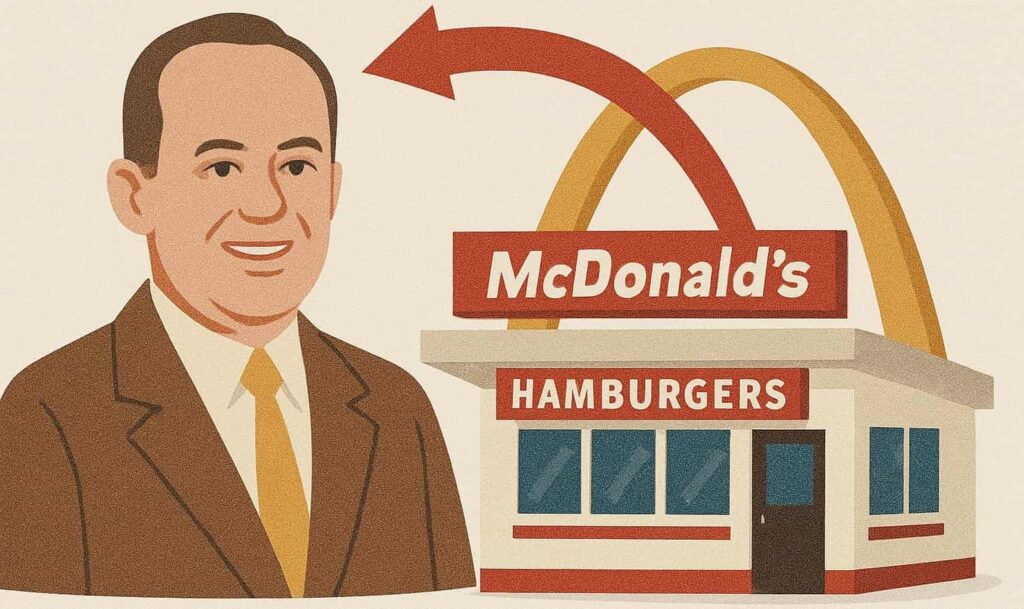When you think of McDonald’s today, you probably picture a golden-arched powerhouse with over 38,000 locations worldwide, selling everything from McFlurries to plant-based burgers. But rewind to the 1940s, and the story is very different. Back then, McDonald’s wasn’t a household name. It was a small barbecue drive-in run by two brothers, Richard and Maurice McDonald, in San Bernardino, California.
And yet, what they built in that decade quietly reshaped not only the way America ate, but the way fast food was marketed. The funny thing? Their marketing strategy didn’t start with billboards or commercials. It began in the kitchen.
McDonald’s Marketing Strategies: How Their Strategy Made You Fall In Love With Them?
1. America in the 1940s: The Stage Was Set
To understand McDonald’s strategy, you need to picture the 1940s. The country was recovering from the Great Depression, navigating the challenges of World War II, and slowly easing into a post-war economic boom. People didn’t eat out as often as they do now it was still a treat.
The social fabric of America was shifting dramatically during this period. Suburban communities were expanding rapidly as returning veterans used GI Bill benefits to purchase homes outside city centers. This migration created new consumer patterns and increased reliance on automobiles for daily activities. Women, who had entered the workforce during wartime, were redefining their roles in society, creating demand for convenient meal solutions that could accommodate busy schedules. The emerging middle class had disposable income but sought value-conscious spending options that didn’t compromise on quality or experience.
Drive-in restaurants were a big deal. They catered to America’s growing love for cars and mobility. A family could pull up, stay in their vehicle, and get served by “carhops” on roller skates. It was part entertainment, part dining.
The McDonald brothers started just like everyone else in 1940: a 20-item menu heavy on barbecue. But they were restless. They noticed something: most of their profits came from just three items: hamburgers, fries, and milkshakes. That single observation changed everything.
2. The Fast Service System – The Real Breakthrough
In 1948, the brothers made a risky move. They shut down their restaurant for three months and rebuilt it from the ground up, introducing what they called the “Speedee Service System.”
This revolutionary approach drew inspiration from Henry Ford’s assembly line methodology, adapting industrial efficiency principles to food service. The brothers studied every movement within their kitchen, timing each step and eliminating unnecessary actions. They redesigned their workspace layout to minimize employee movement and maximize output. Each worker was assigned specific, repetitive tasks that could be mastered quickly, reducing training time and human error. The system also incorporated quality control checkpoints to ensure consistency across all orders. This wasn’t merely about speed; it was about creating a predictable, reliable experience that customers could count on every single time.
This wasn’t just about being faster. It was about rethinking the whole dining experience:
No carhops. Customers came to a single window to place their order.
No plates or cutlery. Everything was wrapped in paper.
Food assembled like clockwork on a production line.
What’s wild is how similar this system is to what we still see today. Orders that used to take 30 minutes were now ready in under a minute. That speed wasn’t just operational efficiency; it was their biggest marketing tool.
Word spread fast. People weren’t saying, “Let’s go to McDonald’s for great advertising.” They were saying, “They serve you in no time.” And in an age before Instagram, Twitter, or even widespread ATL marketing such as TV ads, speed became their billboard.
3. A Menu Trimmed to the Bone
Another bold choice? They slashed their menu from around 20 items to just a handful. Hamburgers, cheeseburgers, fries, milkshakes, soft drinks. That’s it.
The menu reduction strategy was revolutionary for its time, challenging the conventional wisdom that variety equals customer satisfaction. The brothers analyzed their sales data meticulously, discovering that 80% of their revenue came from just 20% of their menu items. This insight led them to eliminate low-performing dishes that complicated operations without generating significant profit. By focusing on core items, they could perfect recipes, streamline ingredient sourcing, and reduce kitchen complexity. The simplified menu also allowed for better inventory management, reducing waste and improving cost control. Most importantly, it enabled staff to become experts at preparing a limited number of items rather than being mediocre at many.
This sounds boring now, but in 1948, it was radical. Most diners offered pages of options. McDonald’s chose simplicity.
Here’s why it worked:
Speed – Fewer items meant faster prep.
Consistency – Every burger looked and tasted the same.
Lower costs – Bulk purchasing and less food waste.
It wasn’t just a kitchen decision; it was a brand statement. They weren’t saying, “We have something for everyone.” They were saying, “We do a few things better than anyone else.” And that kind of clarity makes for powerful marketing, even if you never run an ad.
4. McDonald’s Used Pricing as a Competitive Strategy
Back in the late 1940s, McDonald’s sold a hamburger for 15 cents. For context, the average diner burger was closer to 30–40 cents. That’s like undercutting your competition by half.
The aggressive pricing strategy was made possible through operational innovations that dramatically reduced labor costs and food waste. The brothers calculated that traditional restaurants spent enormous amounts on varied ingredients, complex preparation methods, and skilled kitchen staff. By standardizing their process, they could purchase ingredients in massive quantities, negotiate better supplier rates, and employ workers who required minimal training. The packaging system eliminated dishwashing costs and breakage losses. Additionally, the faster turnover meant they could serve more customers per hour, spreading fixed costs across a larger customer base. This created a competitive moat that traditional restaurants couldn’t easily replicate without completely restructuring their operations.
Lower prices alone don’t guarantee success, but in McDonald’s case, the price fit their story: quick, simple, affordable food for ordinary families. You weren’t going there for a night out, you were going there because it made sense for your wallet.
What’s interesting is how they framed it. They didn’t market it as “cheap.” Instead, they made it feel like smart spending. People left thinking, “Why would I pay more somewhere else?” That’s not just pricing, that’s positioning.
5. Branding Before Branding Was a Thing
Long before the famous Golden Arches, McDonald’s had a mascot: Speedee, a little chef with a hamburger face. His job was to visually represent speed and service, the two things McDonald’s wanted you to remember.
The Speedee mascot was strategically designed to communicate the restaurant’s core values through visual storytelling. The character’s round hamburger head instantly connected with the primary product, while his chef’s hat conveyed culinary expertise and professionalism. His perpetual smile suggested friendliness and satisfaction, creating an emotional connection with customers. The mascot appeared on signage, packaging, and promotional materials, creating consistent brand recognition across all touchpoints. Unlike typical restaurant advertising that focused on food photography or price points, Speedee represented an experience and a promise. The character also helped differentiate McDonald’s from competitors who relied on generic diner aesthetics or focused solely on menu variety rather than service quality.
The brothers also obsessed over the customer experience:
Staff wore clean uniforms.
The kitchen was visible, so customers could see the food being prepared.
Everything looked tidy and predictable.
They were building a brand without using the word “brand.” For 1940s customers, this wasn’t common. Most diners felt different from each other; McDonald’s felt the same every time. That sameness was a selling point.
6. Word-of-Mouth & Local Marketing
In the 1940s, there were no national TV ads for McDonald’s. The brothers relied heavily on word-of-mouth.
The McDonald brothers understood that authentic customer recommendations carried far more weight than paid advertising, especially in tight-knit communities where reputation traveled quickly. They actively encouraged satisfied customers to bring friends and family by ensuring every interaction exceeded expectations. The unique dining experience naturally prompted conversations; people couldn’t help but discuss the novelty of receiving fresh food within seconds. The brothers also cultivated relationships with local business owners, truck drivers, and regular commuters who became unofficial ambassadors for the restaurant. They tracked which customers brought the most referrals and occasionally rewarded them with free meals, creating an informal loyalty program that predated modern customer retention strategies.
How did they make that work?
Location – San Bernardino was right on Route 66, a major travel route. Passing motorists would stop, try it, and tell others.
Car culture – People loved the novelty of pulling up and getting food almost instantly.
Repeat visits – Once you knew you could get a tasty burger in under a minute, you kept coming back.
If you think about it, their marketing funnel was incredibly simple: deliver something worth talking about, and let the customers do the advertising.
7. Operational Consistency as Marketing
One thing McDonald’s understood earlier than most? The experience itself is marketing.
The brothers developed detailed operational manuals that specified exact procedures for every aspect of food preparation and customer service. These guidelines covered everything from burger patty weight and cooking time to employee greeting protocols and uniform standards. They implemented regular quality audits and mystery customer evaluations to ensure standards remained consistent throughout different shifts and peak periods. The predictable experience became a psychological comfort for customers, especially families with children who valued knowing exactly what to expect. This operational consistency also enabled word-of-mouth marketing because customers could confidently recommend McDonald’s to others, knowing their friends would have the same positive experience. The reliability factor was particularly appealing to time-conscious customers who couldn’t afford disappointing meals during limited lunch breaks.
Every burger was the same size. Every fry portion looked identical. Every milkshake tasted exactly like the last one. You didn’t have to wonder if it would be good, you knew.
That reliability built trust. And trust builds habit. People often underestimate how much not surprising your customer can help your business. In a way, the predictability was McDonald’s strongest marketing message.
8. Lessons Modern Businesses Can Still Use
The marketing strategies that worked for McDonald’s in the 1940s still work today, even in a totally different business world:
These principles remain relevant because they address fundamental human psychology and business economics that transcend technological changes. Modern successful companies like Amazon, Starbucks, and Apple have applied similar strategies: Amazon’s obsession with delivery speed mirrors McDonald’s service focus, Starbucks standardized the coffee experience globally, and Apple simplified product lines while maintaining premium consistency. The digital age has actually amplified these principles social media makes word-of-mouth even more powerful, online reviews reward consistency, and e-commerce demands operational efficiency.
Today’s consumers still value time, predictability, and perceived value, though these concepts now extend to digital experiences, subscription services, and omnichannel interactions. To understand how these foundational marketing principles evolved into today’s massive industry landscape, explore the scale and scope of America’s modern advertising and marketing sector, which has grown from these humble 1940s innovations into a multi-billion dollar ecosystem. The core insight remains unchanged: exceptional operational execution often outperforms flashy marketing campaigns.
Simplicity sells – A clear offering is easier to remember.
Speed matters – People value time almost as much as money.
Value positioning beats “cheap” positioning – Make customers feel smart, not frugal.
Brand consistency builds loyalty – Customers return when they know what to expect.
The product is the marketing – Exceptional delivery creates its own buzz.
What’s fascinating is that McDonald’s didn’t start with flashy campaigns. They started with operational innovation and let the service sell itself.
Conclusion
If you strip it down, the McDonald’s key marketing strategy in the 1940s was to create a dining experience so fast, consistent, and affordable that it marketed itself. Everything else, including the mascots, the signage, and the eventual Golden Arches, came later.
And maybe that’s the quiet lesson here: you don’t always need to shout about your brand to get attention. Sometimes you just need to make something people can’t stop talking about.






1 thought on “What Was McDonald’s Key Marketing Strategy in the 1940s?”
Nothing compares to the exquisiteness of an expertly planned marketing strategy, be it for any business. Any business dated on those days has no other choice than mixing up multiple marketing mediums such as paper ads, TV, radio, and even word of mouth. All these brought elite business and revenue; this is a classic symbol of marketing.